

Annual Report 2024

Editorial & Content
Dear Sir or Madam, dear Friends of EuroNatur!
In times of disasters and bad news, fundraising campaigns that promise quick results can be tempting. However, tangible and quickly visible results are a rarity, particularly in nature conservation. Many successes become apparent only after several years or even decades, and setbacks are an everyday occurrence. It’s a marathon, not a sprint: perseverance is the only way to make a difference.
Thank you for recognising the importance of long-term thinking. Thank you for joining us and our partners in speaking out for nature, which is under increasing threat. As Albanian activist Dritan Alsela says in his protest video against the planned destruction on the Albanian coast: “Nature has no lobby, but it has us! Together, we can break the silence from which destruction would emerge.”
2

On behalf of the EuroNatur Executive Committee, and also in my personal capacity, I would like to thank all our donors and funders who allow us to give nature a voice.
I would also like to express my sincere gratitude to the EuroNatur team for their unwavering commitment and professionalism, particularly in challenging times.
This EuroNatur Annual Report for 2024 encourages us all to continue with resolve on the path of nature conservation in Europe. Today, Europe and the world around us need civil society and its commitment more than ever.
Yours sincerely,

Prof. Dr. Thomas Potthast President of EuroNatur Foundation
Orientation map
This map is intended to provide an overview and orientation of the project areas depicted in the EuroNatur Annual Report 2024. The report illustrates the foundation's core topics and working methods by way of examples. It highlights specific successes or challenges in 2024. We are also continuously committed to the protection of Europe‘s natural heritage in projects that could not be presented in detail due to lack of space. A complete overview of all EuroNatur activities can be found in the chapter "EuroNatur’s project foci in 2024". Current developments are covered in the EuroNatur newsletter www.euronatur.org/newsletter-en.
Cantabrian Mountains (Spain)


Carpathians (Slovakia, Romania)
Neretva Delta (Croatia)
Komarnica (Montenegro)
Bjeshkët e Nemuna National Park (Kosovo)
Munella Mountains (Albania)
Mavrovo National Park (North Macedonia)
Narta Lagoon (Albania)
Aoos/Vjosa (Greece, Albania)



Europe‘s forests
Romania's old-growth forests are still at risk
Geographical location in Europe
Carpathians in Romania (Map p. 3, No. 3). The last large old-growth forests in the European Union outside Scandinavia can be found there. Priority areas are old-growth forests in national parks and nature parks, areas of the European Natura 2000 network of protected areas as well as areas of unprotected oldgrowth and natural forests.
Status
The Romanian Carpathians are home to one of the pearls in the crown of Europe's natural heritage. Romania still hosts approximately 500,000 hectares of potential primeval and old-growth forests, accounting for around two thirds of the remaining large primeval forests in the EU outside of Scandinavia. A large proportion of these are primeval beech forests. These forests are home to many species and hotspots of biodiversity. As carbon pools and sinks, these forests also play a crucial role in mitigating climate change. However, huge areas have been logged in recent years, and the destruction of forest biocoenoses that are several thousand years old continues. The state forestry administration, Romsilva, is responsible for managing almost all of the protected forest areas. It prioritises profit over forest protection and grants logging rights to large corporations. Many centuries-old trees are being felled, legally and illegally or “made legal”, even in the most highly protected areas.
Objectives
Our aim is to help preserve the Romanian Carpathians' forest treasures in the long term.












Europe's last wild forests are unique natural treasures and biodiversity hotspots. They are also indispensable allies in the fight against climate change. We want to help protect these ecosystems from exploitation. To this end, taking action at the EU level is an important step.










Illustrations: Kerstin Sauer Photo: EuroNatur - Aerial view of a large shelterwood cutting in Romania.












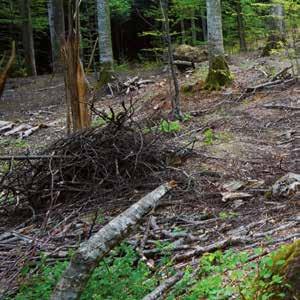
Important activities and achievements in 2024
Perseverance pays off. In October 2024, the European Commission issued a reasoned opinion to the Romanian government. The government was called on to rectify the deforestation problems in the Natura 2000 areas as a matter of urgency. Otherwise, the case would end up in the European Court of Justice. This followed three EU infringement proceedings due to Romanian forestry practices violating the Habitats Directive. The first case was initiated in February 2020 following a complaint by EuroNatur, Agent Green and ClientEarth regarding the illegal logging of primeval and old-growth forests in Natura 2000 sites.
In collaboration with the Environmental Investigation Agency and Agent Green, we demonstrated that deforestation has continued unabated since the infringement proceedings commenced. From 2021 to 2024, more than 4.7 million cubic metres of wood were removed from primeval and old-growth forests in Romania, covering an area of almost 140,000 hectares. This equates to bumper-tobumper lorry loads of timber stretching from Bucharest to Brussels. Roughly half of the deforested areas are located within Natura 2000 sites. We primarily use this data for our lobbying work in Brussels.

Outlook
Although our activities are slowly starting to have an impact, Romania's old-growth forests continue to noticeably deteriorate. We will therefore review our strategy to identify additional measures we can take for leverage.
Partners: Agent Green, Greenpeace Romania
Funding: Nando and Elsa Peretti Foundation, EIA, EuroNatur's donors
Europe‘s rivers
Save the Blue Heart of Europe
Geographical location in Europe
Ecologically valuable watercourses in the Balkans, the blue heart of Europe.
Status
The wild river landscapes of the Balkan Peninsula are among Europe's centres of species diversity. However, the region's rivers are under threat of collapse. A total of 3,282 hydropower plants are planned or under construction in the Balkans, with almost half of these in protected areas. Ninety-two per cent of these projects involve small hydropower plants (< 10 MW), which generate very little electricity but cause devastating and irreversible damage to rivers and wildlife. People are also directly affected by the adverse impacts, through displacement and the loss of their culture.
More than ten years ago, EuroNatur and Riverwatch launched the 'Save the Blue Heart of Europe' campaign in partnership with local organisations. Our commitment has been bearing fruit: While the number of hydropower plants has increased over the past two years, a large network of allies is now in place to protect the last Balkan rivers, at national and EU levels and even globally. Scientists, lawyers and artists are raising their voices in support of the rivers. We have also prompted a rethink within EU institutions and the governments of individual Balkan countries. The civilian population is fighting back against the often unlawful activities of energy companies − some of which are international − as well as political leaders.
Objectives
Our aim is to ensure that the rivers of the Balkans continue to flow freely in future. Among other things, we are committed to ensuring that, following the designation of the Vjosa in Albania as a wild river national park, further river protection areas are designated. This will help to protect the rivers from hydropower plants.
The Blue Heart of Europe
Hydropower is still being marketed as an environmentally friendly form of energy generation. This is putting immense pressure on nature. Many hydropower plants are planned for Southeast Europe, home to some of the last wild rivers on our continent. However, rivers are much more than just sources of electricity. They are among the most species-rich ecosystems on Earth. Together with our local partners in the Balkans, we are working to protect these rivers so that they can continue to flow freely in the future.
Information, photos and videos are available online at www.balkanrivers.net/en or on social media at www.facebook.com/balkanrivers and www.instagram.com/blueheartrivers.




Selected activities and achievements in 2024
As an integral part of the 'Save the Blue Heart of Europe' campaign, we expanded the 'Lawyers for Rivers' network to include fourteen lawyers and legal and political experts from seven countries.
In September, we organised a Balkan River Summit in Montenegro together with our partners. More than 100 river conservationists, experts and activists from various countries attended the event. As well as building expertise, the event made a lasting contribution to strengthening the transnational river protection network. Coverage of the summit in the national media has helped raise awareness among politicians and institutions of the need to protect the Balkan rivers.
The third protest and education camp against the Komarnica dam (Map, p. 3, no. 5) took place in Montenegro. As a result, there has been increased national and international media attention on this issue. Furthermore, a thorough economic analysis demonstrates that the project is not viable, providing robust arguments against its damaging implementation.

Outlook
We will continue to promote dialogue between the campaign teams in individual countries, thereby strengthening the network for the long term. Our ultimate goal is to integrate our river protection activities with sustainable regional development.
Partners: Riverwatch, EcoAlbania, MedINA, CDE MES, DPRS, Ekosvest, GARD, Qendra Network Albania
Funding: 1% for the Planet, Aage V. Jensen Charity Foundation, ClientEarth, Fondation Genevoise de Bienfaisance ‘Valeria Rossi di Montelera’, Holdfast Collective, Manfred-Hermsen-Stiftung, EuroNatur's donors

Photo: Montenegrin Society for Ecology - Protest camp ‘Save Komarnica’ 2023.
Europe‘s rivers
Europe's
first cross-border wild river national park, now!
Geographical location in Europe
The Aoos/Vjosa River in Greece and Albania and its catchment area (Map p.3, no. 10).
Status
The Aoos/Vjosa river, which is more than 270 kilometres long and runs through Greece and Albania, is one of Europe’s last wild rivers. In March 2023, a significant milestone for people and nature was achieved with the designation of the Vjosa and its tributaries in Albania as Europe's first Wild River National Park. The protection of the entire river must now follow, given that the Aoos and the integrity of the Vjosa Wild River National Park are under threat from countless hydropower and infrastructure projects.
The creation of a cross-border Aoos/Vjosa Wild River National Park would protect Europe's last great wild river and offer opportunities for sustainable regional development. We are encouraged by the growing commitment of the Albanian and Greek public to protecting their rivers. However, the different nature conservation practices, legislation and political structures in the two countries present challenges.
Objective
Our aim is to ensure that the entire Aoos/Vjosa river system is protected as a cross-border national park, encompassing the Aoos, its tributaries and the Vjosa delta. All hydropower and infrastructure projects on the Aoos/Vjosa and its tributaries must cease.

We are currently witnessing a paradigm shift in the behaviour of the local community. It's wonderful to see the fruits of our joint labour beginning to bear.
“
Fanikos Sakellarakis,
MedINA



Selected activities and achievements in 2024
The Greek Ministry of the Environment has designated part of the Aoos catchment area as a protected landscape. This means that the construction of any kind of hydropower plant is prohibited in that area.
At the Sarantaporos Science Week in Greece, more than 60 scientists from eleven countries came together to study the Sarantaporos, a tributary of the Aoos which has hardly been the subject of research to date. The results strongly support the protection of the entire Aoos/Vjosa catchment area. There is significant public support, not least due to the media's interest in the Science Week.

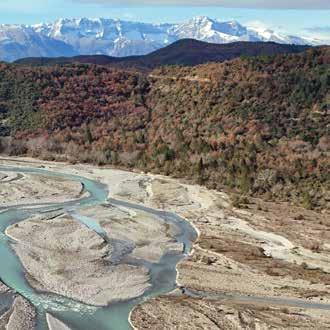

Outlook
We will step up our collaboration with our Albanian and Greek partners and continue working towards our shared goal of establishing a cross-border Aoos/Vjosa Wild River National Park.
Partners: Riverwatch, EcoAlbania, MedINA
Funding: Fondation Genevoise de Bienfaisance „Valeria Rossi di Montelera”, Holdfast Collective, EuroNatur's donors

Photos: Dimitris Papageorgiou - The Sarantaporos, a tributary of the Aoos.
Joshua David Lim - Eel (Anguilla anguilla) caught for research purposes and subsequently released.
Europe‘s rivers
Southern Albania:
Nature versus tourism − we say: No!
Geographical location in Europe
Narta Lagoon in the Vjosa estuary in Albania (Map p. 3, no. 10) and its tributary Shushicë.
Status
The Narta Lagoon, located at the mouth of the Vjosa Wild River National Park, is home to more than 220 bird species, including many endangered species such as the Dalmatian Pelican. The lagoon is of supra-regional importance for birds migrating along the Adriatic flyway to reach their wintering or breeding grounds. However, an international airport has been under construction there since 2021. Construction is due to be completed in 2025, after which the airport will be set to begin operating.
All signs point to the airport becoming the catalyst for significant tourism development in southern Albania. Among other things, it will serve as a strategically important infrastructure project for Donald Trump's son-in-law Jared Kushner, who plans to develop the Vjosa Delta and the island of Sazan for luxury tourism. Furthermore, water is set to be extracted from the Shushicë, one of the Vjosa's most significant tributaries, and directed towards the coastal tourist areas.
All of this has been made possible by a law passed in February 2024, which permits the construction of high-quality infrastructure projects in protected areas provided that they are intended to boost tourism.
Objective
Our aim is to stop the construction of the airport in the Vjosa Delta and prevent its opening. We are dedicated to ensuring that the entire Vjosa catchment area, including the delta, is granted permanent protected status. We are focusing our efforts on repealing the law on the development of protected areas for tourism.
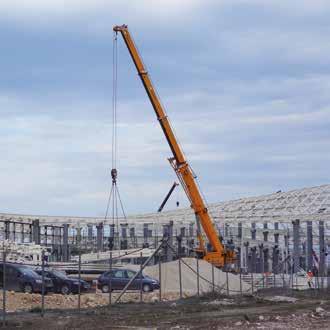



Photo: Zydjon Vorpsi - Construction site of Vlora airport.





Selected activities and achievements in 2024
In April, a 40-strong international scientific delegation collected data in the little-explored Vjosa Delta. This is one of the last unspoilt areas of the Albanian Adriatic coast. The data on the lagoon’s biodiversity and ecological function will serve as a basis for further conservation measures.
Our biodiversity report focuses on Vlora airport (see the chapter on EU policy for more information). The report shows that construction is in breach of national and international (EU) law. Presented to the European Parliament in October, the report supports our call for the construction of the airport to be included as a negotiating item in Albania's EU accession negotiations.
Outlook
We are supporting our partners in taking legal action against the construction of the airport. Our aim is to ensure that the amendment to the law is withdrawn, thereby guaranteeing the permanent protection of the entire Vjosa catchment area and its delta.
Partners: PPNEA, EcoAlbania
Funding: DIMFE, EuroNatur's donors
Photo: Annette Spangenberg - Holiday homes and residential buildings with thousands of rooms are planned on the unspoilt stretch of coast of the Zvërnec peninsula.
European Green Belt
Overcoming borders, protecting nature
Geographical location in Europe
Ecosystem network with an extraordinarily high level of biodiversity, forming a 12,500 km long corridor along the route of the former cold war-era Iron Curtain (Map p.3). The European Green Belt connects eight biogeographical regions and 24 nations.
Status
In the absence of special financing mechanisms, access to funding is often difficult for local actors along the European Green Belt. Small civil society organisations are at a disadvantage compared to larger ones, yet the work they carry out at the local level is often at least of equal value. The EU-funded BESTbelt project enables us to provide training in project acquisition and management to smaller NGOs, as well as financial support for their tangible nature conservation activities along the green network.
Objectives
In the long term, BESTbelt aims to boost the activities of local stakeholders along the European Green Belt, protect biodiversity, and encourage connectivity between species and habitats. Furthermore, we intend to raise awareness of green job opportunities. Through BESTbelt, we aim to raise awareness of the European Green Belt and its unique importance for nature conservation and European history.



„ “
Thanks to BESTbelt, we were able to tell the story of the rebirth of Lusevera, a remote mountain village: regenerated meadows are being grazed again, and restored ponds are teeming with biodiversity.
The abandoned bunkers now provide a habitat for various species of bats that are in sharp decline throughout Europe. These are small measures, but they are of great significance to this area!
F ra ncesca Siardi, Associazione Rete Italiana


Photos: Dietmarl Nill - Greater mouse-eared bat (Myotis myotis); Francesca Siardi



Selected activities and important achievements in 2024
A total of eleven BESTbelt projects were successfully completed in the reporting year, including the “Concrete Actions for Biodiversity (CONABI)” project in Finland and the cross-border “Balkania Route” project. CONABI organised workshops and implemented practical measures to protect local biodiversity, such as constructing insect hotels. The “Balkania Route” project developed the concept for a long-distance hiking trail along the Balkan Green Belt.
A total of 96 project applications were submitted in the third and final call for proposals, and 21 additional projects will receive funding, including seven cross-border projects. These projects aim to support women in rural areas in developing business models for sustainable products and to preserve and market traditional fruit cultivars along the European Green Belt in North Macedonia and Bulgaria, among other things.
Numerous communication and exchange activities took place within the BESTbelt project in 2024. The initiative gained increased awareness through newsletters and website expansion, while regional and Europe-wide conferences promoted knowledge exchange and networking. A particular highlight was the pan-European BESTbelt

conference, which took place in Jurmala, Latvia, on October 14-18, 2024. Twenty-six BESTbelt projects had representatives at the meeting, where they introduced themselves and their projects to the community.
Outlook
In 2025, BESTbelt will prioritise the implementation of projects included in the last two funding rounds. The potential for green job creation will also continue to be explored.
Partners: BUND Green Belt Division, BUND Mecklenburg-Western Pomerania, Executive Board of the European Green Belt Association
Funding: European Union, EuroNatur’s donors
Bear, wolf & lynx
Spain's last bears
Geographical location in Europe
Cantabrian Mountains in northern Spain (Map p. 3, No. 1). The valleys of Omaña and Luna in the north-west of the province of León, south of the Cantabrian Mountains.
Status
Thanks to decades of intensive conservation efforts, brown bears are spreading further and further south of the Cantabrian Mountains. Although the bears are still under great threat, particularly from illegal hunting and uncontrolled bear-watching tourism, this development offers hope. Around two years ago, Fapas set up a second base in Omaña, primarily to prevent conflicts between bears and humans in the bears’ new range. However, the political conditions under which Fapas operates are becoming increasingly challenging. The government is unwilling to cooperate with the NGO, and in some cases, it is even blocking Fapas' conservation activities. This makes it all the more important that the organisation retains its financial independence from state funding and can operate independent of party political interests.
Objectives
Our aim is to save the brown bears in the Cantabrian Mountains from extinction. We also want to ensure that the bears spread and survive in the long term.


For decades now, we have been working alongside other nature conservation organisations and donors like you to protect bears, wolves and lynx in Europe. EuroNatur believes that wild animals have a place in Europe, even though coexisting with them can be challenging.
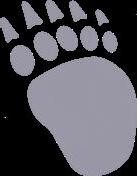



Selected activities and achievements in 2024
In the Omaña and Luna valleys, Fapas recorded thirteen bears during the reporting period. These included four two- to three-year-old animals, as well as at least two females capable of reproduction. It is reasonable to assume that a small but stable population of bears has already established itself there.
In order to protect beehives in the region from hungry bears, and thus prevent conflicts between humans and bears, Fapas provides beekeepers in the new range with specially developed electric fences. This has been successful: in 2024, there were no reports of bears entering apiaries protected in this way.
Through the “Fruit Trees for Gourmets” pilot project, Fapas was able to increase local acceptance of bears in the province of León. Around Tejedo del Sil, where a hate campaign had been launched against the female bear “Lechuguina” in the year prior, 50 fruit trees from the Fapas nursery were planted and protected from browsers. The landowners received a premium of €10 per tree and are now permitted to harvest the fruit. This initiative creates new food sources for the bears at a safe distance from the village and also enables Fapas to foster positive relationships with the local community.

Outlook
If sufficient funding can be organised, Fapas will continue to intensify its efforts to protect brown bears and their habitats in León province.
Partner:
Fapas
Funding : EuroNatur's donors and sponsors
Bear, wolf & lynx
This is dangerous momentum, not just for wolves. “
At its annual meeting in Strasbourg in December 2024, the Standing Committee of the Bern Convention voted to reduce the level of protection afforded to wolves under the Habitats Directive, changing their status from 'strictly protected' to 'protected'. An assessment by Mareike Brix.
Despite urgent recommendations to the contrary from numerous scientists, expert groups and environmental organisations, including EuroNatur, this decision was forced through by the EU Member States and is expected to be incorporated into the Habitats Directive in 2025. It will subsequently have a significant impact on national legislation. Attempting to weaken the protected status of the wolf, contrary to scientific findings, undermines the credibility of EU environmental policy and recklessly puts at risk years of conservation efforts.
Lobby organisations such as FACE, the umbrella organisation of hunters in Europe, and the German Farmers' Association (DBV) celebrated the decision. However, from the perspective of the 300 civil society organisations that signed an appeal to this effect, including EuroNatur, it is anything but a success. This concerns conservation efforts in Europe as a whole. The removal of strict protections for wolves under the Bern Convention and the Habitats Directive paves the way for the further erosion of species protection in the European Union, making it extremely difficult to argue against future moves against other ‘inconvenient' species, such as bears, beavers and otters.
It is hoped that the long-awaited decision on the wolf will encourage a solution-oriented dialogue between the various interest groups. Given this, it is all the more important to promote the coexistence of wolves and humans, and to implement and improve effective measures to protect grazing livestock. EuroNatur will continue to work towards this end, driving forward appropriate initiatives together with our partners.


M areike Brix, Head of Programme Large Carnivores „ “
The erosion of wolf protection sets a precedent that could endanger the entire European ecosystem.

Slovakia: Using facts to combat misinformation

Wolves were added to Slovakia's list of strictly protected species in 2021. However, after three years of no hunting, the government has decided to resume wolf hunting in the 2024/25 season. Indepen dent and objective monitoring and constructive dialogue are now more important than ever!
In 2024, EuroNatur provided financial support to the Slovak Wildlife Society (SWS) to ensure the continuation of the wolf monitoring programme in the Carpathians. Through genetic analyses, the SWS has identified 47 different wolves in the Liptov project area. This figure is around six times lower than that reported in the official hunting statistics. In October, the SWS presented the results of the wolf monitoring programme to the Ministry of Agriculture.
Wolf monitoring programme in the Carpathians
Over ten years ago, the European Commission began infringement proceedings against Slovakia at the request of several environmental organisations, citing high cull quotas and noncompliance with the requirements regarding wolves set out in the Habitats Directive. To improve monitoring of the wolf population and resolve discrepancies regarding the number of wolves in the country, the Commission funded a one-year pilot project based on citizen science and modern genetic analysis in 2013. This was so successful that the Slovak Wolf Society (SWS) incorporated the approaches into its annual Carpathian Wolf Watch monitoring programme, which has been running since 2010. At present, the SWS no longer receives government funding. In light of the increasing pressure on wolves, it is urgent that this wolf monitoring programme continues. The programme enables a reliable, independent assessment of the size and development of the wolf population, providing objective data beyond emotional discussions about cull quotas.
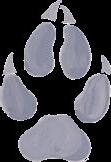

Partner: SWS
Funding : EuroNatur's donors and sponsors

Bear, wolf & lynx
Five to midnight for the Balkan lynx
Geographical location in Europe
Mountainous border regions on the Balkan Green Belt between Albania and North Macedonia and between Albania, Montenegro and Kosovo. Special focus areas are the Mavrovo National Park in North Macedonia, the Munella Mountains in Albania and the Bjeshkët e Nemuna National Park in Kosovo (Map p.3, No. 8, 7 and 6).
Status
The Balkan lynx is an endangered subspecies of the Eurasian lynx. Currently its presence has only been confirmed in the Balkan Green Belt, which lies on the border between North Macedonia and Albania, and in a smaller area in northern Albania and western Kosovo. According to current estimates, fewer than 50 individuals remain. Habitat destruction and directed hunts, as well as hunting of its prey species, have severely depleted the Balkan lynx population. Competition for food with stray dogs is also a serious problem.
Objectives
The aim is to re-establish a long-term, self-sustaining Balkan lynx population. The protection of the lynx benefits many other species and entire habitats. Measures to protect the Balkan lynx should be carried out with the backing and support of the local population.





With the governments of North Macedonia and Albania on our side, we can more effectively combat the extinction of the Balkan lynx.
“
D ime Melovski, MES

The Balkan lynx has been added to the species falling under the Convention on the Conservation of Migratory Species (CMS). The application had been submitted by the North Macedonian government. The Albanian government, among others, supported the initiative. By doing so, government representatives have committed to creating the best possible conditions for protecting the Balkan lynx. In the run-up to the decisive CMS conference, EuroNatur partners MES in North Macedonia and PPNEA in Albania lobbied their respective governments to reach this milestone. Dime Melovski from MES presented the proposal at the CMS conference in Samarkand.
The low population density of the Balkan lynx has been proven since 2024, based on a scientific study. Moreover, a genetic study has already demonstrated the occurrence of inbreeding. These findings provide strong evidence that the population should be bolstered by introducing lynx from other populations.
A survey of over 1,200 people living within the Balkan lynx's range reveals that the majority of the local population supports protective measures for the species.
In important lynx habitats in North Macedonia, our partners at MES supported veterinarians in catching feral dogs, neutering them, and then setting them free again. This helps solve the problem of food competition from strays in the long term.

Outlook
By the end of 2025, a regional strategy for the protection of the Balkan lynx will have been developed, which will then be translated into national action plans. A feasibility study on increasing the population by reintroducing lynx from other populations is currently underway.
Partners: MES, PPNEA, ERA, Stiftung Kora
Funding: Fondation Hans Wilsdorf, EuroNatur's donors and sponsors
Photos: Photo trap picture Balkan lynx (Lynx lynx balcanicus)
- Dime Melovski from
Europe's migratory birds

Working to ensure safe migration routes
Geographical location in Europe
Bird habitats along the Adriatic Flyway, which runs from north-east and central Europe through the Balkans to Africa. Numerous project areas in six Western Balkan countries: Slovenia, Croatia, Serbia, Bosnia-Herzegovina, Montenegro, and Albania.
Status
The greatest threat to this group of animals comes from the destruction of their habitats, as well as from hunting, trapping and trade. It is estimated that 25 million birds are illegally killed or removed from the wild every year in the Mediterranean region alone. Some species, such as the Turtle Dove and the Egyptian Vulture, are highly endangered as a result of hunting.
Objectives
Together with our partners, we are working tirelessly to permanently stop the annual killing and trapping of migratory birds, and to preserve their habitats across national borders. To this end, we are mobilising various interest groups to put pressure on the governments of Southeast European states. As signatories to key bird protection conventions, these governments are obliged to combat illegal bird hunting within their borders. Unfortunately, very few of the officials in charge consider this issue to be a high priority one. This makes civil society involvement all the more important when it comes to demanding that governments implement these conventions and agreements.




Birds can inspire a love of nature in people. However, Europe's birdlife is in a poor state, partly due to the ongoing illegal hunting of these migratory birds.
Since its establishment, EuroNatur Foundation and its partners have been working to protect Europe's migratory birds.











Selected activities and achievements in 2024
Our partners along the Adriatic Flyway have documented a total of 2,024 illegal activities, primarily in the field, but also at markets and in online trade. Our Croatian partners at Biom, for example, organised a volunteer programme in which 40 people took part. They monitored Bee-eater colonies and Golden Eagle breeding sites, documented illegal bird hunting in the Neretva Delta, and reported the illegal sale of birds at markets in Zagreb.
In Bosnia-Herzegovina and Montenegro, our partners developed socio-economic questionnaires to find out more about the background to illegal bird hunting. The aim is to use this data to identify new approaches to reducing illegal hunting.






The Neretva Delta (Map, p. 3, no. 4) is a hotspot for bird hunting in Croatia. While primarily coots are shot there, this activity also affects other bird species. Our partners at Biom therefore organised a campaign against the consumption of coot meat at the end of 2024. Bird conservationists reached more than 500,000 people in the Dalmatia region with posters and flyers reminiscent of Christmas adverts, as well as radio spots and digital campaigns.
Our partners at DOPPS have conducted a thorough analysis of Slovenian legislation concerning the unlawful killing of birds. This could be used to suggest improvements to legislation in Slovenia and may also inspire other countries.
Photo: Dietmar Nill - Coot
Europe's migratory birds


Outlook
How much progress have we made towards our goal of reducing illegal bird hunting in the Mediterranean by at least 50 per cent by 2030? To answer this question, we developed a mid-term target for 2024 in collaboration with our partners and under the leadership of BirdLife. This will be presented — and put to use — in 2025. The mid-term analysis aims to encourage government officials to take action by providing them with practical recommendations on how to effectively combat illegal bird hunting.
Partners: BirdLife International, BirdLife Europe & Central Asia, BirdLife Middle East & BirdLife Africa, VCF, Tour du Valat, BPSSS, HDZZP, Biom, Naše ptice, CZIP, PPNEA, AOS, DOPPS
Funding: Fondation Hans Wilsdorf, EuroNatur's donors and sponsors


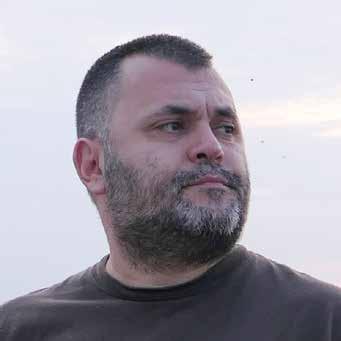
„ “
The quail hunters don't shoot the birds for food, but mainly for fun. They call it a sport, but in reality it is wholesale slaughter.
Milan Ružic , BPSSS
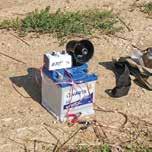

Photos: depositphotos / V. Kucherenko - Garganey (Spatula querquedula)





Stopping quail poachers
It is estimated that at least 160,000 Common Quails are killed illegally each year in Serbia, Montenegro, Croatia, Albania and BosniaHerzegovina. These high cull numbers represent a significant loss, given that these birds have become increasingly rare.
The same illegal method is often used for hunting: Poachers place sound lures in meadows and fields at night to lure quail coveys heading to their wintering grounds in Africa. The quails, lured by the sound of their own kind, settle down in the dark, and at sunrise the poachers shoot the blackbird-sized birds by the thousands. This method kills far more Common Quails than legal methods would.

For years now, EuroNatur and its partner organisations in the Balkans have been campaigning to put an end to illegal quail hunting. During the south-east European mild late-summer nights, bird conservationists sacrifice their weekends to listen out for illegal sound lures. Once they have discovered them, the teams report them to the police. It is a sleep-depriving and at times even hazardous activity, but one that saves the lives of thousands of Common Quails.
During the 2024 hunting season, our partners conducted more than 70 night-time monitoring tours in Serbia alone, working in a number of teams. They identified a total of 46 cases of quail hunting using illegal decoy lures.
Partners: BirdLife Europe & Central Asia, BPSSS, HDZZP, Biom, Naše ptice, CZIP, PPNEA, AOS, DOPPS
Funding: Fondation Hans Wilsdorf, EuroNatur's donors and sponsors
EU policy
More money for biodiversity conservation
One of the key levers we used at the EU level in 2024 were the European Union's multi-annual financial plans, specifically the plan running until 2027 and the one covering the period from 2028 to 2034. To meet Europe's biodiversity conservation and restoration targets and commitments, the EU budget would need to allocate €48,000 million per year to nature conservation by 2030. The corresponding statement, which is available on our website at enatur.org/b, was drawn up by EuroNatur and provides proposals on how the EU can improve its funding for biodiversity protection. Eight other nature conservation organisations, including Bankwatch, Wetlands International and ClientEarth, have endorsed EuroNatur's demands therein.
In the EU Member States of Central and Eastern Europe in particular, EU funds are often the only source of funding for nature conservation and restoration. The criteria for allocating these funds must be improved urgently to ensure that the money is used effectively and not misused for environmentally harmful projects. Positive pilot projects are also needed to provide guidance to non-governmental organisations, citizens and authorities on how EU funds can be put to good use. Together with our partners, we identified several such projects and defined the criteria and principles that make them model projects. We also analysed environmentally harmful projects and demonstrated how they could have been prevented. Since 2024, a specially developed tool (available at bankwatch.org/documenting-harmful-projects) has enabled individuals, citizens' groups and NGOs to independently document and, where possible, report environmentally harmful projects. This tool provides a step-by-step guide in seven languages to help users quickly assess the potential impacts of a project, justify their concerns regarding the project and share these with potential allies or the relevant authorities. The tool also aims to prevent similar projects from receiving EU funding in the future.
We have succeeded in raising awareness among decision-makers of the challenges and opportunities in promoting biodiversity, and in promoting constructive exchanges on the topic in Brussels and selected EU Member States.
Geographical focus: European Union, Brussels, Poland, Latvia, Slovenia, Croatia, Hungary.
Partners: PGN, Green Liberty, DOPPS, Zelena Akcija, NSC
Funding: German Federal Ministry for the Environment
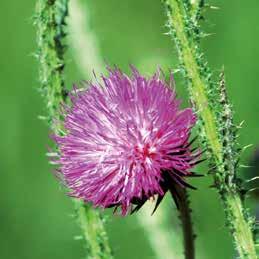
EuroNatur represents the common good interests of civil society and nature in Brussels. Our goal is to ensure that investments are directed towards achieving the EU's major environmental targets.
In the course of the EU's enlargement process, we aim to make EU environmental legislation a top priority.


Photo: Kerstin Sauer - Thistle in Bulgaria.



Facts, not speculation: The EuroNatur Biodiversity Report
The Western Balkan states are home to rare species landscapes that at least in part are still untouched. Although these natural treasures are nominally protected by national legislation and international agreements, they are under significant threat from various developments and activities, including infrastructure projects such as airports in wetlands, illegal bird hunting, and habitat destruction. Such violations undermine the conservation objectives of the EU Birds Directive and the EU Habitats Directive, as well as the Bern Convention, with serious consequences for endangered species such as the Balkan lynx or the Dalmatian Pelican.
In November 2024, together with our partners we lead-published a report (see pdf file at enatur.org/e), which effectively closes a critical gap in Brussels with regard to biodiversity conservation. Using five case studies, we demonstrate successful nature conservation practices, particularly at the local level. At the same time, the report highlights the ongoing destruction of nature in the Western Balkans.
Viktor Berishaj, Senior Policy Officer at EuroNatur and lead author of the study, explains: “Our results show that nature conservation is not a priority for the Western Balkan countries. Protected areas should be safe havens for biodiversity, but in reality there is a worrying tendency towards mismanagement and neglect.”

The biodiversity report serves as a key reference for understanding how problems can be solved at various levels, and it highlights opportunities for reversing the trend and securing the future of ecosystems in the Western Balkans. It was presented at the European Parliament in Brussels on 21 November 2024. Following coverage by journalists and other NGOs, the public was made aware of our key findings and recommendations.
We will use the biodiversity report to ensure that the implementation of EU environmental legislation becomes a top priority in the EU enlargement process. Moreover, we will combine political work with practical conservation projects in the Western Balkans, utilising our extensive network of partners.
Partners: MES, CZZS, CZIP, BPSSS, PPNEA, Stiftung Kora
Funding : EuroNatur's donors
Media and PR work


Media furore for Vjosa and Co.
In 2024, worrying news about the Vjosa river made headlines. Plans to build an airport near the Vjosa estuary and to extract water from the Shushicë, one of the Vjosa's most important tributaries, threaten the integrity of Europe's first wild river national park.
Balkan Insight, 10 Jul 2024
Welcome to the Vjosa River Delta in Albania, where a real-life Delta Force is not fighting villains but an equally daunting foe: environmental degradation. This unique delta, set at the mouth of Europe’s first Wild River National Park, is an unbreakable battalion of biodiversity, its flora and fauna forming the frontline in nature's own blockbuster against environmental harm. Recently, a coalition of scientists, NGOs and conservationists assembled not to rehearse scripted lines but to document and advocate for the preservation of one of Europe’s most vibrant and vital biodiversity hotspots.



Osservatorio, 22 Jul 2024
"After Vjosa was proclaimed a national park (in March 2023, ed.), we felt safe. But it was just an illusion", explains Hysni. "They cheated.“ […]The residents' committees were joined not only by activists from Tirana and other areas of the country, but also by an international network born from the campaign Save the Blue Heart of Europe that united regional battles against hydroelectric plants. The outcome is by no means a foregone conclusion, but the work has begun: bynight, before justice is pronounced. It is a race against time, but the people of Shushica will not stop.
The Washington Post, 17 Aug 2024
Environmentalists argue that this coastal area [in Albania] is one of the most important habitats in Europe, characterised by its natural diversity: There are sand dunes that harbour loggerhead turtles and a lagoon that serves as a refuge for waterfowl. A 2021 report by Andrej Sovinc, a protected areas expert working on behalf of the IUCN, states that the lagoon ‘has significant conservation value at the national and even global level’.
Photos: Annette Spangenberg - Laying pipes for the water extraction project on the Shushica. Shushica River, part of the Vjosa river system.
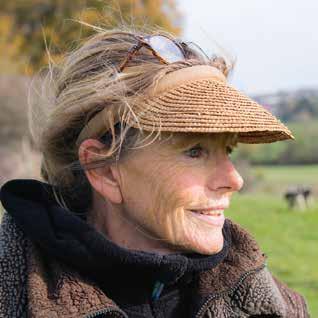


If our aim is to bring about a turnaround in the farming sector, we must work together to make progress, despite the economic competition between market participants. The trick is to act in concert, be that in research, in the associations or on farms.
Dr. Anita Idel
EuroNatur Award for species-appropriate farming
It is not cows that are responsible for climate change, but rather the energy-intensive agro-industry. This is especially true when cattle are fed and kept in a species-appropriate manner. This is the central thesis that Dr Anita Idel has been advocating for decades. On 10 October 2024, she received the 2024 EuroNatur Award “in recognition of her exceptional personal dedication to promoting welfare-friendly and ecologically sustainable agriculture”. You can find impressions from the award ceremony online at euronatur.org/award24
Bye-bye, Twitter
EuroNatur stands for respectful and democratic communication based on appreciation. However, we could no longer see any basis for this on X, which is why, back in June 2024, we decided to turn our backs on the short messaging service, formerly known as Twitter. In protest against the significant increase in hate speech on X since Elon Musk took over the platform, we decided to take this step together with 50 other non-profit organisations. We now have an account on Blue Sky, an alternative to X; feel free to follow us there: bsky.app/profile/euronatur.bsky.social
Please refer to page 28 for more details on the digital channels you can use to follow our work and engage with us.
Photos: Katharina Grund - Herd of cows in the Bohemian Forest. Katrin Denkewitz - EuroNatur Award winner 2024 Dr Anita Idel.
EuroNatur on social media
If you would like to receive daily updates about our work, follow us on social media! We are...

... growing on Facebook
By the end of 2024, more than 10,000 people were following EuroNatur on Facebook, marking a significant milestone for us. Your likes, constructive comments and shares of our posts have motivated us to create more exciting, informative and also humorous content. Please continue to accompany us on this journey at facebook.com/euronatur
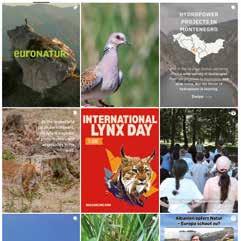
... active on Instagram
We share amazing animal photos and impressive landscape shots, accompanied by fascinating information about our work. Follow us on Instagram to marvel at the beauty of Europe's nature and share our posts!
instagram.com/euronatur

... busy on LinkedIn
Follow our dedicated staff and EuroNatur on LinkedIn! We offer a glimpse into our varied work, which transcends national borders. Do you have something to share with us, or would you like to show your appreciation for what we do? Please comment on, share and like our posts. Would you like to get involved? Contact us on LinkedIn!
linkedin.com/company/euronatur

... new on BlueSky
In an era of hate speech and fake news, particularly prevalent on social media, our goal is to provide a credible alternative. We could no longer see a future for this on X (see also page 27). Follow us on BlueSky instead, where we aim to gradually build a diverse and comprehensive network.
bsky.app/profile/euronatur.bsky.social
Dealing with potential risks
For a non-profit foundation, EuroNatur Foundation’s capital stock is relatively slim. Therefore the organisation is urgently dependent on donations and third-party grants so as to be able to discharge its mandate as an advocate of nature in Europe. We are aware of the fact that with this funding comes great responsibility and day in, day out we work towards using the funds as efficiently as possible. Due to differences in legal systems, language barriers and potentially greater corruption risks, the manner in which these grants and donations are passed on to partner organisations abroad is also a sensitive issue, one that is predicated on a very good network of contacts built up over many years. Moreover, a multilevel control system is essential for the correct assessment of and effective response to risks. Risk mitigation measures must also be adopted for capital investments.
Potential risks and the measures we take to avert them
Financial and economic crises
The cost of living remains high for everyone following the significant impact of the Covid-19 pandemic, ongoing geopolitical tensions, and the consequences of the energy price crisis. When investing money, it is becoming increasingly difficult to strike the right balance between security and returns.
The most important thing to guide us on this journey: EuroNatur Foundation invests equity in a way that poses as little risk as possible, applying ethical and ecological criteria while offering good returns. Moreover, we build up reserves in order to compensate for possible fluctuations in revenue. For any necessary depreciation of fixed assets, we have built up a special reserve for gains from transactions in recent years. We are using this reserve to offset losses from the disposal of financial assets in 2024.
Lack of competent and trustworthy partner organisations
EuroNatur Foundation has very consciously not opted for a Europewide network of offices with full-time employees, thus eliminating considerable administrative expenditure. We are primarily concerned with cooperating with existing conservation organisations that are well connected in their local areas and are successful in their endeavours. In many countries of southern and eastern Europe, non-profit, independent conservation organisations are few and far between. The lack of competent and trustworthy partners limits our options. It is for this reason that EuroNatur invests in the systematic
development and strengthening of civil society in southern and eastern Europe. EuroNatur’s project work is always predicated on cooperation with a local partner organisation. If there is no such partner organisation in a particular region, it is reason enough for EuroNatur not to engage.
Misappropriation of funds
We have self-imposed strict rules on budgetary control. All outward payments are checked for mathematical and factual correctness. Payment orders are always subject to the “Two-man rule”. Target-performance comparisons are carried out on a monthly basis, allowing for swift detection of potential irregularities. Our 2024 annual accounts were audited by the independent auditing and tax accounting firm WISTA AG and endorsed with an unqualified audit certificate.
Inefficiencies and ineffectiveness in project work
We regularly scrutinise our internal processes, which allows us to continuously increase our efficiency. We also analyse the work of our partner organisations and work with them to find possible ways to increase their efficiency and effectiveness. Our partners’ statements of expenditure are checked by the project liaison person for factual accuracy and by the accounting department for financial accuracy. All statements of expenditure are submitted to the managing director for approval prior to funds being released. In order to increase the efficiency of our work we conduct staff development and training, in terms of both content and methodology, for ourselves and our partners on an ongoing basis.
Transparency – one of EuroNatur’s important tenets
EuroNatur was again awarded the DZI Seal of Approval In 2024, EuroNatur Foundation was once again awarded the DZI (German Central Institute for Social Issues) Seal of Approval. It will expire at the end of the third quarter of 2025. The Seal of Approval certifies that, amongst other things, EuroNatur meets the DZI’s seven standards as follows: EuroNatur conducts its work in keeping with its statutes; the organisation management and oversight are adequately structured, clearly separated and are being exercised effectively; in our solicitation of donations and public relations work we provide information in a clear, truthful, factual and open manner; we openly and comprehensively report on our work, structures and finances; remuneration is paid taking into consideration the organisation's charitable status, qualifications, levels of responsibility, and customary pay standards; the procurement and use of funding as well as the organisation’s financial status are traceability documented and adequately verified; the proportion of funds spent on advertising and administration in 2023 was at an acceptable level in accordance with the DZI standards (“acceptable” = 20% to 30%).
The effectiveness of the organisation's spending is monitored and results are documented and published.
Initiative for transparency in civil society
EuroNatur has been a signatory to Transparency International Germany’s “Initiative Transparente Zivilgesellschaft” (Initiative for transparency in civil society) since 2010. Signatories to the initiative voluntarily commit to publishing ten particular items of information about their organisation on their homepage. These include i.a. their statutes, the names of essential decisionmakers, and information on how they are funded, how they use their funding, and their personnel structure.


Auditing
In 2024, the EuroNatur Foundation once again enlisted the services of an auditor to conduct a voluntary audit of its annual financial statements. The auditing and tax accounting firm WISTA AG audited EuroNatur Foundation’s 2024 annual accounts in accordance with Par. 317 ff. of the German Commercial Code (HGB) and in accordance with the accepted standards for the review of financial statements as set out by the Institute of Public Auditors in Germany (IDW) and endorsed the accounts with an unqualified audit certificate. An extract from the audit certificate states the following:
“We have audited the annual financial statements, consisting of the balance sheet as of December 31, 2024, profit and loss account for the fiscal year from January 1 to December 31, 2024, and the Annex. Additionally we audited the management report for the fiscal year from January 1 to December 31, 2024.
In our opinion, based on the information obtained during our audit, the financial statements as attached are in all material respects compliant with the applicable requirements of German commercial law for all traders, and provide a true and fair view of the Foundation's financial position.
In all material respects this position statement is consistent with the German statutory commercial law provisions applicable to all traders, and adequately depicts the opportunities and risks arising from future developments. Pursuant to Section 322 (3)(1) HGB (German Commercial Code) we declare that our audit did not lead to any objections as to the correctness of the annual financial statements or the position statement.
June 16, 2025, WISTA AG, Mannheim

Transparency
Capital investment based on environmental and ethical criteria
EuroNatur Foundation’s foundation capital now amounts to almost EUR 7.95 million. Moreover, EuroNatur Foundation holds assests of more than EUR 2.17 million in trust for the benefit of three non-autonomous foundations. In keeping with the organisation's philosophy, investment decisions are based on environmental and ethical criteria. Both inclusion and exclusion criteria are applied to these decisions. As a minimum, investment products are not considered if they invest in companies involved in nuclear power, agrochemicals, weapons, genetic engineering, pornography, alcohol, tobacco, the fossil fuel vehicle industry, the oil and coal industries, airline companies, or if they are invested in government bonds in nations practicing capital punishment, actively driving forward nuclear energy, or which are considered corrupt. Our main financial service providers for asset management purposes in 2024 were the Bank Vontobel Europe AG, Munich Branch, and the V-BANK AG in Munich, Germany. We manage a large part of the assets ourselves and since the summer of 2017 we have also consulted with an independent financial advisor on a fee basis.
System of remuneration
The Foundation is organized in three departments: Conservation, Communication and Administration. These departments provide for the following functional levels: Administration/Communication I-III, Project Assistance, Project Management I and II (Conservation), Policy Assistant, Policy Officer, Senior Policy Officer, and Head of Department. Remuneration bands have been set for each of the levels, extending 20% either side of the mid-point. In 2024, the mid-point of the remuneration bands was as follows:
Administration/Communication I: € 49k
Administration/Communication II: € 53k
Administration/Communication III: € 63k
Project assistance: € 45k
Project management I: € 57k
Project management II: € 67k
Policy Assistant: € 45k
Policy Officer: € 55k
Senior Policy Officer: € 65k Head of Department: € 71k
In 2024, the Executive Director received an annual remuneration package of € 108k gross. Without exception all members of the Presiding Committee and the Board of Trustees act in a voluntary capacity and only receive reimbursements for cost incurred, but no flat-rate expense allowances.
Advertising and donor information
Six times a year EuroNatur Foundation sends out information to its donors to keep them in touch with ongoing projects and request support for concrete endeavours. Similarly, support for individual projects is solicited, and information provided, through the organisation's website at www.euronatur.org, the digital EuroNatur newsletter and emailings. In addition, regular donors receive the EuroNatur magazine four times a year as well as topical project reports containing comprehensive information and reports on current developments in the projects. In 2024, EuroNatur Foundation conducted its own donor liaison and fundraising. In addition to printers and EuroNatur Service GmbH, the following external service providers were commissioned for marketing and fundraising activities: Agentur Socialmind, Agentur Nerd Solutions, Agentur Neun GmbH, Agentur Deutsche Fundraising Company.
Impact monitoring and impact analysis
One of the most important tenets of EuroNatur’s work is the efficient deployment of funds entrusted to us by our donors and by the organisations (both governmental and non-governmental) that support our work. Systematic planning of activities and comprehensive impact monitoring are preconditions to the efficient use of funds.
EuroNatur Foundation takes both a supportive and an operative role. For projects undertaken by EuroNatur in cooperation with its partner organisation, and which in most instances are in receipt of third-party financial support (from both governmental and nongovernmental sources), EuroNatur reports back in detail to the financial backers. Impact monitoring already begins at the stages of project development and project application. EuroNatur develops projects based on comprehensive situational analysis and needs assessments. Together with our partners we formulate the overall objectives and prepare project applications based thereon for the acquisition of funding from third parties. These project applications can only attract funding if the objectives are clearly set out and if activities are proposed that serve to meet these objectives. Evidence of the use of funds must include comprehensive evaluations of the achievement of set objectives as well as rationales for potential changes in or adjustments to activities or even objectives. In order to receive grants from EuroNatur, applicants must present cohesive project designs in keeping with the principles set out above. The partner organisation's reports are subject to comprehensive evaluation by EuroNatur and our project managers regularly visit the project areas to discuss the projects’ progress.
Both positive developments and difficulties arising are assessed in order to allow for procedural adjustments to be made and to learn lessons for the future. Progress reports document project development up to the point of the projects’ completion.
Economic Situation
A Year of Light and Shadows
A great annual result, despite not inconsiderable losses: EuroNatur's managing director, Gabriel Schwaderer, reflects on 2024 with mixed emotions.

Let’s start with the most important question: How did EuroNatur Foundation fare financially in 2024?
It was a very positive year, but it also presented us with particular challenges. We achieved a surplus of €1.2 million in 2024, which is very pleasing indeed. This surplus is due to a very high level of bequests. However, we could have achieved an even better result. Compared to our budget planning, we were €800k short at the end of the year.
What caused this unusually large gap?
There are several reasons for this gap. The financial result is around €240k below the planned result; a large part of this lower income is due to losses on financial assets. While this is disappointing, it does happen from time to time. To fulfil our statutory purpose, we must generate income from asset management and take calculated risks. However, we have taken precautions in the past by creating reserves in years when we generated extraordinary yields. We are now reducing this special reserve in order to compensate for the current losses.

Donors form the basis
In 2024, EuroNatur Foundation’s regular donors, sponsors and legacy donors continued to provide the financial footing for our tangible conservation efforts in Europe as well as for political lobbying, campaigns, awareness-raising and environmental education. Once again, EuroNatur also attracted substantial financial support for project implementation, primarily from private foundations and associations as well as from public sector funding in 2024, most notably from: Aage V. Jensen Charity Foundation,
Photo: Kerstin Sauer





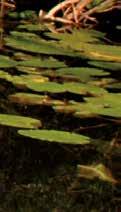
Austrian Development Agency, Bernd Thies Foundation, Federal Ministry for the Environment, ClientEarth, German Federal Environmental Foundation (DBU), DIMFE – Donors‘ Initiative for Mediterranean Freshwater Ecosystems, Dr. Manfred und Gudrun Keim Fund, European Union, Fondation Prince Albert II de Monaco, Fondation Hans Wilsdorf, Holdfast Collective, MSA – Monk Seal Alliance, Nando and Elsa Peretti Foundation, Fondation Genevoise de Bienfaisance, Lappat Fund, Ludwig Raue Memorial Fund, German Environment Agency.
But there have been other losses as well. How can these be explained?
At the operational level, our goal was to raise more donations. We fell short of our target by around €380k at the end of the year. Our target was however highly ambitious. It is difficult to find more supporters for our important nature conservation work. While we are very happy and grateful for the enormous loyalty shown to us by the EuroNatur community, we wish to and must broaden it further. Another factor contributing to the losses are increased personnel costs, and we had also anticipated receiving more income from subsidies. However, our main concern this year was VAT, both structurally and financially.
Photo: Gabriel Schwaderer - Hutovo Blato, wetlands in Bosnia and Herzegovina.
Economic Situation
But VAT is not relevant for non-profit organisations that are not commercially active. So why did the EuroNatur Foundation still have to deal with this issue?
In 2024, contrary to our previous assumptions, we came to the conclusion that EuroNatur must be classified as a VAT-taxable business. This is despite the fact that the EuroNatur Foundation is not commercially active. The mere fact that we manage properties bequeathed to us results in this categorisation. However, this yields no advantages for the Foundation, only disadvantages. Due to our non-profit status, we cannot claim input tax, so we always pay the gross amount, just like private end customers. Worryingly for VATtaxable businesses, the VAT liability is reversed when commissioning foreign service providers – something that happens frequently in our international work − meaning that the Foundation, as the recipient of the services, must pay VAT on same services to the German exchequer. For non-profit organisations this is a highly ambiguous and opaque regulation. It also poses major challenges for other organisations.
DZI Seal of Approval
In June 2025, EuroNatur Foundation was again awarded the DZI (German Central Institute for Social Issues) Seal of Approval. EuroNatur had applied for the seal in February 2025 based on its 2023 annual accounts. The result of the DZI assessment of EuroNatur Foundation was a positive one: It confirmed that we meet the seven DZI Seal of Approval standards (please refer to page 30).




Photo: Guiseppe Bonali - Ant (Formica).


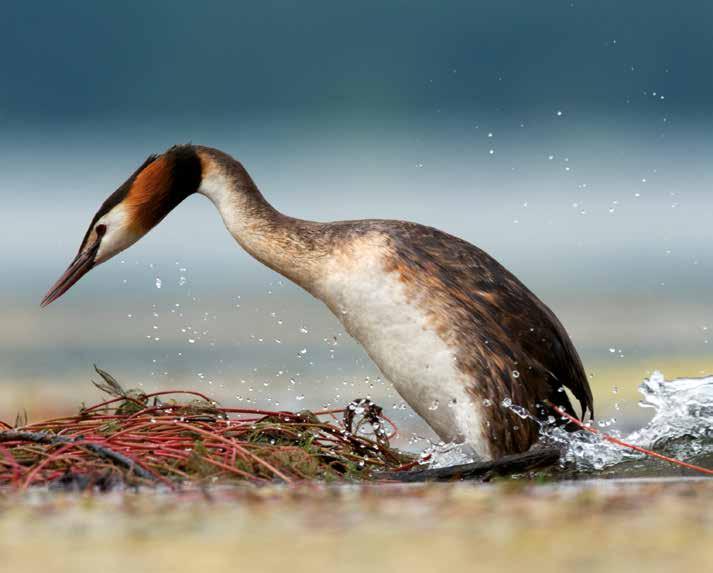

What does this mean for the Foundation in practical terms?
We proactively calculated the VAT payable by EuroNatur for 2024 and previous years, and paid €280k to the relevant tax office. This created an extraordinary financial burden in the 2024 financial year.
In most cases, we have now effectively paid VAT twice for these years: once to the service provider abroad and once to the relevant tax office in Germany.
We have thus corrected the application error we identified, in conformity with the rules.
Photo: Andrea Fiora - Great Crested Grebe (Podiceps cristatus).
Economic Situation

Which facts stand out on the expenditure side in 2024?

In our history, there has only been a single year in which we were able to support our partners with higher amounts: 2022. That was the last year we were in receipt of funding from the MAVA Foundation. Therefore, to almost achieve this result again now, two years after MAVA, is very positive and really quite amazing. Obviously, the increase in project funding over the years has enabled us to better support our partners, but it has also led to an increase in personnel costs and other expenses on our side.
Private donations and bequests are a pillar of our funding. Once again, in 2024, generous bequests were made to the Foundation. What happens to them?
Bequests and endowments are very important to us and a great display of trust. They are important to the Foundation because they strengthen its financial standing. With the proceeds from asset management, we can secure the contributions required for projects, among other things. In 2024, we were able to transfer more than three quarters of the bequests totalling €2.05 million to our Foundation's capital stock, thereby further strengthening the Foundation's financial base − the Foundation's capital stock now amounts to almost €8 million. Bequests like these contribute directly to the long-term protection of Europe's natural heritage. The Foundation's equity now totals €10.2 million, providing further substantial reinforcement.
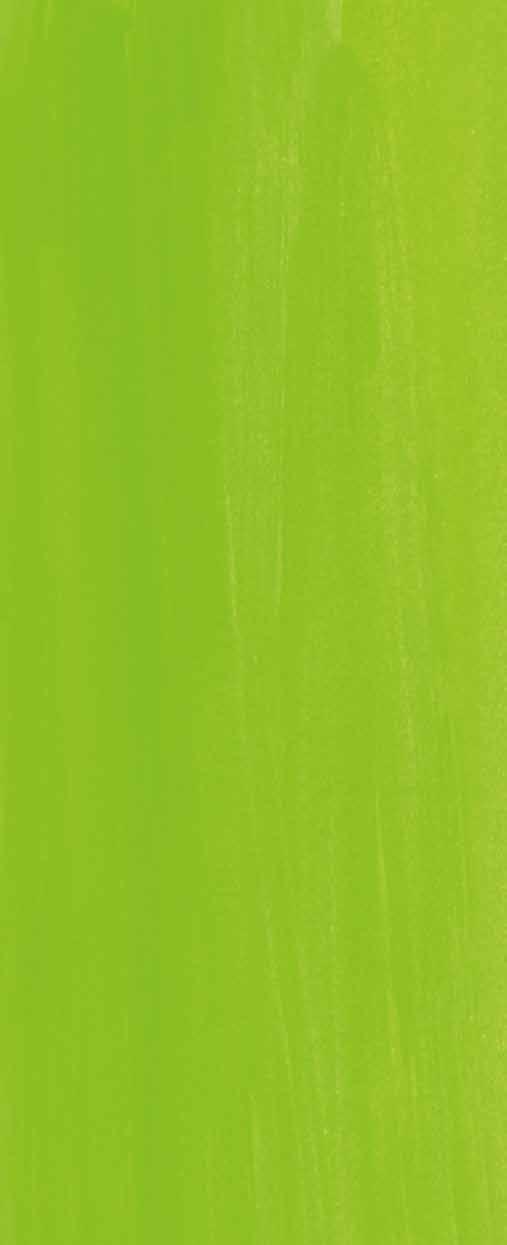

Presentation of the Activity Report in accordance with DZI specifications
The income and expenditure headings used for the purposes of this Activity Report correspond to the prescribed specifications as part of the guidelines for the DZI (German Central Institute for Social Issues) Seal of Approval. The headings therefore diverge somewhat from the customary breakdown set out in the Handelsgesetzbuch (German Commercial Code), especially in the profit and loss account. Amongst the criteria assessed by DZI is an important threshold value, i.e. the share of expenditure on advertising and administration to total relevant expenditure. Not all expenditure is included for the purpose of calculating the share of administrative expenditure: Expenditure on portfolio management and commercial activities are not taken into consideration.
Photo: Carola Teichgräber - Brimstone butterfly (Gonepteryx rhamni).

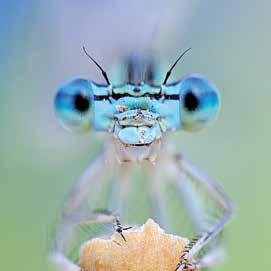

Looking back at the past year, is the outlook for 2025 and beyond more pessimistic? What does the foundation expect in the coming years? What are the expectations and foreseeable challenges for the Foundation as it approaches its 40th anniversary in 2027?
We jointly developed a ten-year strategy, providing us with a clear plan and direction for our work, which is becoming increasingly important in times of worsening environmental crises. Our goal is to continue being the strong European voice for nature conservation in the Balkans and Southeast Europe. Our work at the European level has intensified, and we are increasingly recognised as competent experts. We have succeeded in placing our own issues on the agenda and have gained recognition in relevant circles. That is a great development. However, we are all aware that biodiversity and nature conservation initiatives are currently facing significant challenges at the national and supranational levels. Our core issues are unpopular at the moment, and the work of non-governmental organisations is becoming increasingly difficult. But we will not be deterred from the path we have taken with our fabulous partner organisations, and with the support of our donors.
Questions by: Anja Arning
Photo: Guiseppe Bonali - White featherleg (Platycnemis latipes).
Economic Situation

A testament for European nature
A further strengthening of EuroNatur Foundation’s asset base is of great importance for its independence and performance as a successful advocate for nature in Europe. The increase in the foundation’s capital creates planning certainty and independence. Endowments and bequests therefore provide immensely valuable support to us and are a great sign of confidence, confidence that we endeavour to honour with our commitment. In 2024, a large proportion of the endowments and revenue from bequests were transferred to the Foundation’s capital stock. This, same as the endowments received, has further strengthened EuroNatur Foundation’s financial position. We expect that revenues from portfolio management will, as a minimum, remain stable in the coming years.
Bequests and legacies in 2024
In 2024, the following individuals (listed alphabetically) bequeathed funds to EuroNatur Foundation upon their death. We are greatly indebted to them and will honour their memory.
Johannes Peter Delker
Heinz Uwe Haase
Dr. Christina Michaela Kraft
Dr. Alexander und Rita Annette Prestel
Friedrich Wilhelm Seehars

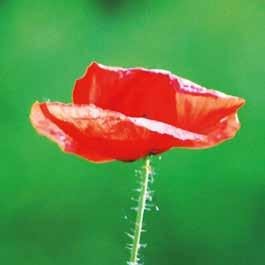

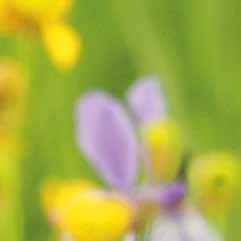

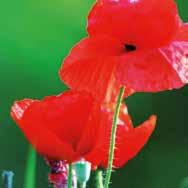

Non-autonomous foundations and named funds
In 2024, EuroNatur managed three non-autonomous foundations and three earmarked named funds. The named funds’ capital (€ 502k) was increased by € 3k compared to the previous financial year while the capital of the non-autonomous foundations (€ 2,169k) remained unchanged. In the reporting year, yields from non-autonomous foundations continued to exclusively benefit EuroNatur project activities.
Dr. Manfred and Gudrun Keim Fund
Ludwig Raue Memorial Fund
Lappat Fund
EuroNatur Fund for Eastern Germany
EuroNatur Fund for the Protection of Migratory Birds
Elisabeth Seifert-Becker’s endowment fund for the protection of wolves in memory of Viktoria Neumann, Emilie and Franz Seifert
Working together for Europe’s nature
EuroNatur’s successes in nature conservation in Europe in 2024 could only be achieved with the support provided by our donors, sponsors and legacy donors as well as providers of grants and commercial sponsors. We are most grateful for your support!
Photo: Kerstin Sauer - Common Poppy (Papaver rhoeas).
Profit & Loss Statement for 2024
Expenditure according to DZI
In the 2024 financial year, collection inflows totalled EUR 3,120 thousand, of which EUR 150 thousand have not yet been allocated due to earmarking and are expected to be allocated in the following year, when the funds are actually utilised. The collection inflows also include endowments amounting to EUR 10,205.65 (previous year: EUR 96,480.65); these are not presented in the profit and loss account.
EuroNatur’s project foci in 2024


In 2024, the projects implemented by EuroNatur Foundation focused on the following areas:
Protecting the European Green Belt and further advancing the European Green Belt Initiative
Protecting Europe’s rivers and river landscapes
Protecting migratory birds in Europe
Protecting large carnivores in Europe
Protecting Europe’s last wild forests
Protecting species-rich cultural landscapes in Europe
EU nature conservation policy
This Activity Report describes a selection of projects under individual priority headings. EuroNatur Foundation has supported and implemented a number of additional projects and initiatives over and above these priorities, a more detailed description of which is beyond the scope of this report.




Priority
“European Green Belt”
Funding spent on this priority: 1,733,102 Euro
Projects:
Protection and development of the European Green Belt and ongoing advancement of the initiative (Partners: all EGBA members as well as the actors involved in the European Green Belt initiative; Funding: EuroNatur’s donors), BESTbelt - Connecting and protecting unique landscapes throughout Europe by empowering local stakeholders (Partners: BUND, EGBA and stakeholders involved in the European Green Belt Initiative; Funding: European Union, EuroNatur's donors), Strengthening NGO-led Conservation in the Transboundary Prespa basin (Partners: MES, PPNEA, SPP; Funding: Aage V. Jensen Charity Foundation, EuroNatur’s donors)
Priority “Protecting Europe’s rivers and river landscapes”
Funding spent on this priority: 1,066,576 Euro
Projects:
“Save the Blue Heart of Europe” campaign (Partners: Riverwatch, EcoAlbania, MedINA, CDE MES, DPRS, Ekosvest, GARD, Qendra Network Albania; Funding: 1% for the Planet, ManfredHermsen-Stiftung, Fondation Genevoise de Bienfaisance "Valeria Rossi di Montelera", Holdfast Collective, Aage V. Jensen Charity Foundation, Client Earth, EuroNatur’s donors), Saving Europe’s last free flowing wild river – Vjosa/Aoos (Partners: Riverwatch, EcoAlbania, MedINA; Funding: Fondation Genevoise de Bienfaisance „Valeria Rossi di Montelera”, Holdfast Collective, EuroNatur’s donors), Protecting the Narta Lagoon in the Vjosa Delta from destruction by the Vlora International Airport Project (Partners: PPNEA, EcoAlbania; Funding: DIMFE, EuroNatur's donors), Commitment to a free-flowing Oder river (Partners: Eko-Unia, Friends of the Earth Germany (BUND); Funding: EuroNatur's donors)
EuroNatur’s project foci in 2024



Priority “Protecting migratory birds in Europe”
Funding spent on this priority: 501,328 Euro
Projects:
Safeguarding the bird migration route along the Adriatic Flyway Partners: BirdLife, VCF, Tour du Valat, HDZPP, Biom, DOPPS, BPSSS, CZIP, Naše ptice, AOS, PPNEA; Funding: Fondation Hans Wilsdorf, EuroNatur’s donors), Nature Returns – an alternative model for funding and managing protected areas through promoting conservation-based businesses to local stakeholders, e.g. in Ulcinj Salina Nature Park, Šar Planina National Park and Lonjsko Polje Nature Park (Partner: Nature Returns – lead partner; Funding: Nature Returns, EuroNatur’s donors), Cross-border initiative to restore the aquatic warbler population (Partner: BEF – lead partner; Funding: EU LIFE, EuroNatur's donors), Protecting European wet meadows and pastures, in particular in the European Stork Villages (Partners: European Stork Villages and their national conservation partners; Funding: EuroNatur’s donors)

- Aquatic Warbler (Acrocephalus paludicola).

Priority “Protecting large carnivores in Europe”
Funding spent on this priority: 1,011,873 Euro
Projects:
Protecting brown bears in the Cantabrian Mountains (Partner: Fapas; Funding: EuroNatur’s donors), Protecting brown bears in Serbia (Partner: BPSSS; Funding: Bernd Thies Foundation, EuroNatur’s donors), Cross-border protection of brown bears in the tri-border area of Albania, North Macedonia and Greece (Partners: PPNEA, MES, Callisto, Ekosvest; Funding: EuroNatur’s donors), Protecting brown bears, lynx and grey wolves in the northern Dinarides (Partner: University of Zagreb, Carnivora Magna; Funding: EuroNatur’s donors), Balkan Lynx Recovery Programme (Partner: CZIP; Funding: Bernd Thies Foundation, EuroNatur's donors), Lynx monitoring in Montenegro (Partner: CZIP; Funding: Bernd Thies Foundation, EuroNatur's donors), Funding the continuation of Carpathian Wolf Watch (Partner: SWS; Funding: EuroNatur's donors), Protection of large carnivores
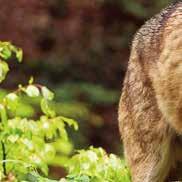


in Baden-Wuerttemberg, Guidelines for dealing with wolves (Partners: EuroNatur is a member of the ‘Arbeitskreis Wolf’ working group as part of the ‘AG Lynx Baden Wuerttemberg’ working group, Funding: EuroNatur’s donors), Protecting the Mediterranean monk seal colony at Cap Blanc (Partner: CBD Habitat; Funding: EuroNatur’s donors), Protecting Mediterranean monk seals in the Eastern Adriatic (Partners: MOm, PPNEA, CZIP, Biom; Funding: MSA, EuroNatur’s donors)
EuroNatur’s project foci in 2024
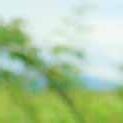

Priority “Protecting Europe’s last wild forests”
Funding spent on this priority: 246,660 Euro
Projects:
Protecting old-growth and primeval forests in Romania (Partners: Agent Green, Greenpeace Romania; Funding: NEPF, EIA, EuroNatur’s donors), Cross-border protection of primeval and old-growth forests in the Western Balkans (Partners: PPNEA, ERA, CZZS, CZIP, Biom, MES, BPSSS; Funding: Aage V. Jensen Charity Foundation, EuroNatur's donors), Ecological forest conversion of monoculture pine forests in Brandenburg to seminatural mixed forests (Partners: Nature Park administrations at Dahme-Heideseen, Märkische Schweiz, and Schlaubetal; German Federation for Nature Conservation (Nabu) - Märkische Schweiz regional association; Stiftung Naturschutzfonds Brandenburg; local conservation groups and farmers; Funding: EuroNatur Trust for Eastern Germany, EuroNatur’s donors)
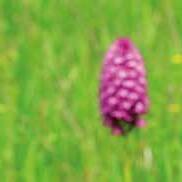

Priority “Protecting species-rich cultural landscapes in Europe“
Funding spent on this priority: 357,346 Euro
Projects:
Support for the protection and sustainable regional development of the Bosnian karst polje Livanjsko Polje (Partners: Naše ptice, CZZS, Livno Youth Centre; Funding: DIMFE, NEPF, GBTN, EuroNatur's donors), Flagship projects for a sustainable future in the Šar-Korab-Koritnik cross-border mountain range (Partners: MES, PPNEA, CNVP, LAGs FOSH, LAG Korab-Koritnik, LAG Šarri; Funding: Aage V. Jensen Charity Foundation, EuroNatur's donors), Safeguarding two important bat roosts in Brandenburg and Poland (Funding: Interreg, Ludwig Raue Memorial Fund, EuroNatur's donors)
Priority “EU nature conservation policy”
Funding spent on this priority: 359,711 Euro
Projects
Biodiversity financing (Partners: Bankwatch, PGN, Green Liberty, Zelena Akcija, DOPPS, NCS Hungary; Funding: German Federal Ministry for the Environment), Biodiversity Report for the Western Balkans (Partners: MES, CZZS, CZIP, BPSSS, PPNEA, Stiftung Kora; Funding: EuroNatur's donors)




Abbreviations
Partners:
AOS: Albanian Ornithological Society
Biom: BirdLife Croatia
BEF: Baltic Environmental Forum (Lithuania)
BPSSS: Bird Protection and Study Society of Serbia
BUND: Friends of the Earth Germany
CBD Habitat: Foundation for the Conservation of Biodiversity and its Habitat in Spain
CDE MES: Montenegrin Ecologists Society
CNVP: Connecting Natural Values and People
CZIP: Center for Protection and Research of Birds of Montenegro
CZZS: Center for Environment in Bosnia-Herzegovina
DOPPS: BirdLife Slovenia
DPRS: Slovenian Native Fish Society
EGBA: European Green Belt Association
EIA: Environmental Investigation Agency
Fapas: Wild animal protection fund (Spain)
GARD: Group of Rural Activists of Dibra
HDZPP: Croatian Society for Bird and Nature Protection
Funding:
DIMFE: Donors' Initiative for Mediterranean Freshwater Ecosystems
GBTN: Giving back to nature
EU-LIFE: Environmental Financial Instrument of the European Union
MSA: Monk Seal Alliance
NEPF: Nando and Elsa Peretti Foundation
PONT: Prespa Ohrid Nature Trust
Kora: Foundation for carnivore ecology and wildlife management in Switzerland
LAG: Local Action Group
MedINA: Mediterranean Institute for Nature and Anthropos
MES: Macedonian Ecological Society
MOm: Hellenic Society for the Study and Protection of the Monk seal
NSC: National Society of Conservationists (Hungary)
OTOP: Association for the protection of birds in Poland
NSC: National Society of Conservationists
PGN: Polish Green Network
PPNEA: Protection and Preservation of Natural Environment in Albania
SPP: Society for the Protection of Prespa
SWS: Slovak Wildlife Society
USPB: Ukrainian Society for the Protection of Birds
VCF: Vulture Conservation Foundation
Photo: Kerstin Sauer - Common poppy (Papaver rhoeas) in a grain field.
EuroNatur – Connecting nature and people Mission & Vision




We are committed to connecting nature and people in a peaceful Europe – beyond national borders. Our donors support us in this endeavour.
The growth-oriented way we lead our lives and run our economies at this point in history is characterized by ruthless exploitation of natural resources and has resulted in the pervasive destruction of nature as well as in drastic climate change. People all around the world are feeling the resultant adverse effects.
Nature is the natural resource base on which all humans depend. Species and habitat diversity are prerequisites of a quality environment. Our aim is a European continent that hosts free-flowing rivers, pristine forests and diverse cultural landscapes and that offers sufficient space for wild animals and migrating birds within these and other ecosystems.
OUR MODE OF OPERATION
Our efforts for the protection of plants, animals and habitats are transboundary in nature; we strengthen local conservation organisations and create international networks between them. Together with our Europe-wide partner network we create solutions that allow humans to live and work in harmony with nature.
Our way of working focuses on supporting third parties (our partners). We bring specialist expertise in our fields and actively contribute to the operational side of projects. We strive for a relationship of trust and equal partnership with our collaborators.

In our work we follow a well-proven approach:
KNOWING
Using reputable scientific studies, we provide evidence of the conservation importance and uniqueness of species, landscapes and habitats and of the threats they face.
PROTECTING
We work on driving forward the formal protection of endangered species as well as of habitats and landscapes of particular high ecological value. To this end we utilize national and international political structures.
SAFEGUARDING
Protected areas and species must be given sustained effective protection. We support control measures and make our demands for rigorous protection measures heard in national and international political institutions as well as in the courts. Where necessary, we exert public pressure on decision-makers (for example by way of protests and media attention).
LIVING
We generate acceptance of the need for protection and potentially associated restrictions for the local communities. Together with the local people we establish ecologically compatible land-use methods in protected habitats that open up socio-economic prospects. This helps us to win over local people as partners for achieving our conservation objectives, thus laying the groundwork for the long-term effectiveness of our efforts.

Our values


RESPONSIBILITY
We take responsibility for the issues to which we are committed, the geographical areas we work in, and our partners, with whom we aim to have long-term relationships.
We are reliable and work with foresight, regularly scrutinising our effectiveness. We take responsibility for the outcomes of our work.
We take responsibility for ourselves and each other.
INDEPENDENCE
We are independent in our positions and do not compromise the integrity of our substantive work or our ideals. We strive for financial independence wherever possible. We also enable our partners to work effectively, free from external interference.


RESPECT
Respect is the foundation of all our actions. We treat people and nature with sincere respect and honour one another. We treat each other with appreciation and openness for all lived realities. It is important to us to communicate respectfully and listen to different viewpoints.
INTEGRITY
We stand up for these values and ideals. Even in difficult situations, we show backbone and stand firm. We keep our promises and are reliable partners.


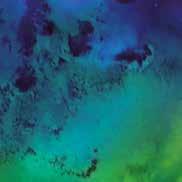
Organisation & structure




A Foundation to protect Europe’s nature
EuroNatur is a non-profit foundation established in 1987 by Friends of the Earth Germany (Bund für Umwelt- und Naturschutz Deutschland, BUND), the German Federation for Nature Conservation (Naturschutzbund Deutschland, NABU) and Environmental Action Germany (Deutsche Umwelthilfe, DUH). It is headquartered in Radolfzell. EuroNatur is legally, organisationally and financially independent, autonomous and non-partisan. A foundation having legal personality (rechtsfähige Stiftung) such as EuroNatur differs from a registered voluntary association (Verein) in that it has no membership base. The latest exemption notice (Freistellungsbescheid) was issued by the tax authority in Singen on April 29, 2025. EuroNatur is a member of, amongst others, the following organisations: European Green Belt Association e.V., International Union for Conservation of Nature (IUCN), European Habitats Forum, German League for Nature Conservation and Environmental Protection (DNR), AgrarBündnis e.V. and Wetlands InternationalEuropean Association.
The current Articles of Association can be downloaded at www.euronatur.org/statutes
Presiding Committee provides strategic orientation
New members of the Presiding Committee are proposed by existing members and elected to the Committee by majority vote. The President is elected from among the members of the Presiding Committee. In 2024, EuroNatur’s Presiding Committee had six voting members, all of whom served in a voluntary capacity. Their duties include determining the organisation's strategic orientation, approving annual budgets, and approving the annual accounts. The Presiding Committee oversees the work of the Executive Director and the Director of Conservation Policy with a view to its lawfulness, expediency and economic efficiency. Detailed Committee member profiles can be accessed at
www.euronatur.org/en/about-euronatur/organization/presidingcommittee.

Board of Trustees serves as an advisory committee
EuroNatur’s Presiding Committee can nominate persons to the Board of Trustees who support the organisation's concerns. In 2024, EuroNatur’s Board of Trustees had 17 members, all of whom served in a voluntary capacity. They support EuroNatur in three areas: technical advice, especially with respect to access to funding; public relations work; establishing the organisation and its work more firmly within society. The Chairman of the Board of Trustees attends the meetings of the Presiding Committee in an advisory capacity. Detailed profiles of the Members of the Board of Trustees can be accessed at www.euronatur.org/en/about-euronatur/ organization/euronatur-board-of-trustees.
Salaried management staff in charge of operative implementation
The Executive Director is in charge of and responsible for steering the organisation's operative work. In the reporting year, EuroNatur employed a total of 38 staff, who are active in the units of conservation, administration and public relations. More than 30 voluntary collaborators support the work of EuroNatur Foundation.
EuroNatur Service GmbH
Thirty years ago, the EuroNatur Foundation established a wholly owned subsidiary, the EuroNatur Service GmbH, a limited company. This small but efficient service provider publishes and markets landscape and wildlife calendars and guidebooks on EuroNatur’s project regions as well as a wide range of reference books and exclusive items. Additionally the EuroNatur Service GmbH has specialised on layout and mail order services which it provides to the EuroNatur Foundation and other clients.
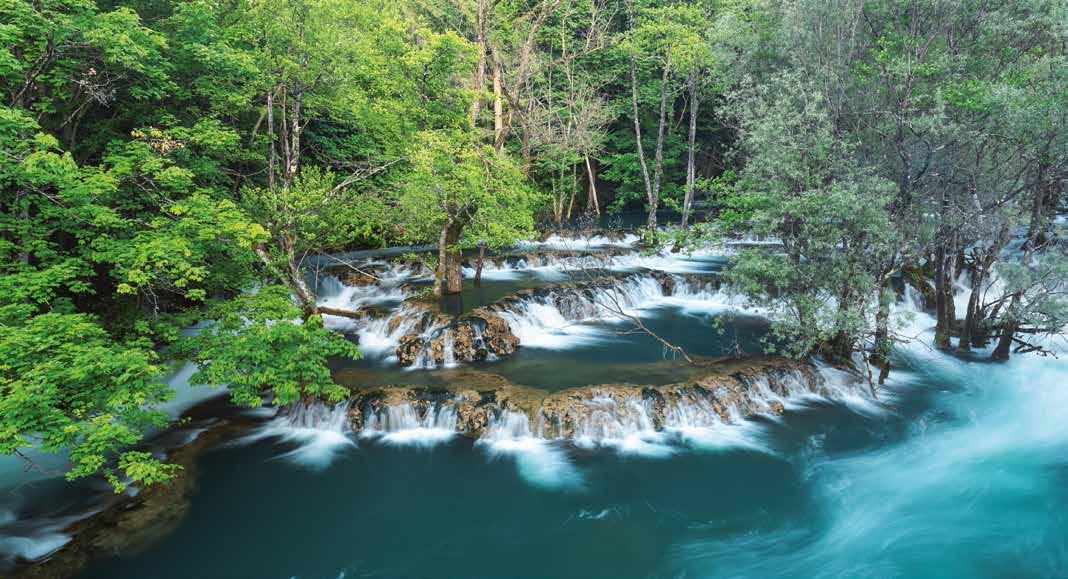

A testament for European nature
With a testamentary gift or a legacy bequest to EuroNatur, you can help us preserve a Europe beyond your own lifetime in which there are free-flowing rivers, unspoilt forests, diverse cultural landscapes and sufficient space for wild animals. Read an interview with Ines Fantinato, donor liaison at EuroNatur.
When EuroNatur is the recipient of bequests, where do they go?
Bequests are a tremendous gift and a vote of confidence that we handle with great care. When someone considers us in their will to help preserve Europe's nature, that is a wonderful thing to do. If they wish to support bear projects only, for example, then we honour this wish. Bequests without purpose limitations are however advantageous, as EuroNatur can use the funds wherever they are needed most.
EuroNatur is part of the Mein Erbe tut Gutes (‘My Legacy Does Good’) initiative. What is that about?
Alongside 26 other organisations, we are dedicated to raising awareness of charitable bequests. The initiative's contacts are qualified individuals who, without trying to persuade anyone, highlight ways to do good beyond one’s own lifetime. They provide further information and contacts, no strings attached.
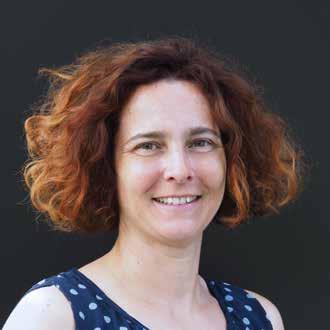
Donors form the basis
If you would like to find out more about bequests, please visit
www.euronatur.org/en/legacy-giving or contact
Ines Fantinato ines.fantinato@euronatur.org Fon: + 49 7732 9272 16.




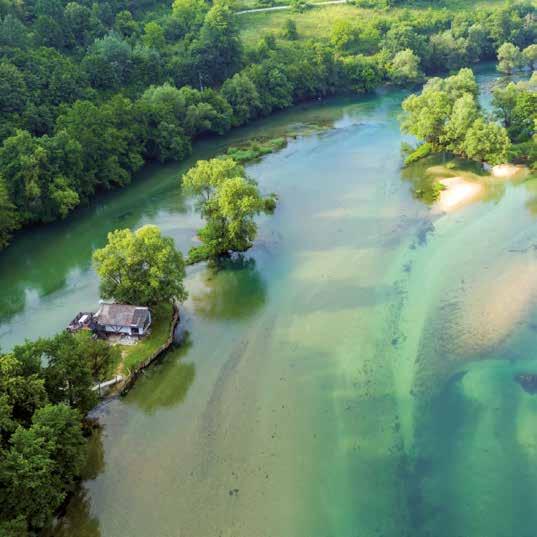


Who should make a will?
For anyone who wishes to ensure that their estate is dispersed as they intended, it is essential that they make a will. Legal succession only takes direct blood relatives into account. Especially for those who have no descendants, it is important to consider what they would like to happen to their estate. If they want to leave money to organisations such as EuroNatur, they must make provisions to that effect in their will.
My hope would be that wills were no longer filled with such gravity, and that people would talk about them more openly. So much can be achieved through a will! Even though it means dealing with the fact that one's own existence is finite, the drafting of a will can be a very enriching experience.
What can people achieve by making a bequest to EuroNatur?
They pass on their values and stand up for what is important to them beyond their own lifetime. That's a great opportunity to pass something on and also to give back, for example if someone found being in nature particularly inspiring or invigorating during their lifetime. Dealing with death may feel strange at first. However, I have noted a sense of liberation in those who have addressed the issue. Reflecting on what I would wish to pass on is a commitment to life itself.
Interview: Katharina Grund
Imprint

Front:
Isabel Wintermantel, Ines Fantinato, Nadya Moussa, Dr. Amelie Huber, Leonie Kraut, Marion Lenz, Katharina Grund, Christian Stielow, Kerstin Sauer
Middle row:
Daniela Löchle, Samuel Carleial Fernandes, Markus Dressnandt, Lola Arriola, Justine Vansynghel, Anja Arning, Cornelia Mähr, Anika Konsek, Annette Spangenberg, Anne Katrin Heinrichs, Lisa Leschinski, Gabriel Schwaderer
Back row:
Antje Henkelmann, Michael Fantinato, Dr. Stefan Ferger, Leonard Sonten, Jessica Bitsch, Silvana Mielke, Anja Nieden, Viktor Berishaj, Mareike Brix, Siegmund Missall
The EuroNatur team in June 2025 (in rows from left to right):





Presiding Committee
President: Prof. Dr. Thomas Potthast
Vice president: Dr. Anna-Katharina Wöbse
Members of the Presiding Committee: Prof. Dr. Hannes Knapp, Dr. Elsa Nickel, Jörg Nitsch, Prof. Dr. Hubert Weiger
Executive Director
Gabriel Schwaderer, Radolfzell
Ombudsperson ombudsperson@euronatur.org
Imprint
EuroNatur Stiftung Westendstraße 3
D - 78315 Radolfzell
Fon + 49 (0) 7732/92 72 0
Fax + 49 (0) 7732/92 72 22
info@euronatur.org www.euronatur.org
facebook.com/euronatur youtube.com/euronatur bsky.app/profile/euronatur.bsky.social instagram.com/euronatur linkedin.com/company/euronatur
Writers
Anja Arning, Katharina Grund (Editor-in-chief), Anika Konsek, Gabriel Schwaderer (V.i.S.d.P.), Christian Stielow
Translation
Ute Bohnsack, Email: agroeco@eircom.net
Cover photo
Sadar Faizan - Lichens
Cover & graphic design
Kerstin Sauer; EuroNatur Service GmbH ISSN 0945-148X
Printing
Fischer Druck GmbH & Co. KG, printed on 100% recycled paper
Donations
SozialBank / Bank für Sozialwirtschaft, Köln
IBAN DE42 3702 0500 0008 1820 05
SWIFT/BIC BFSWDE33XXX
Conservation needs action - and money!
Our successful work is built on targeted strategies, efficient methods, sound knowledge, rich practical experience and respectable partner organisations in the project regions. But existing opportunities translate into concrete measures only with the help of our donors.
Donations to registered charities such as EuroNatur are tax-deductible. Please help Europe’s nature and wildlife.
Please spread the word and help us find new supporters for EuroNatur!
www.euronatur.org
The DZI (German Institute for Social Issues) seal of approval certifies that EuroNatur is serious, transparent and uses donations wisely and effectively.
Photo: Kerstin Sauer - View of Radolfzell from the Höri peninsula.
